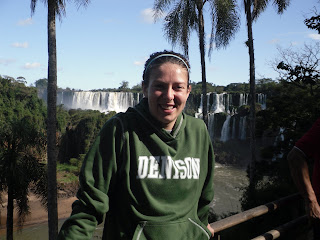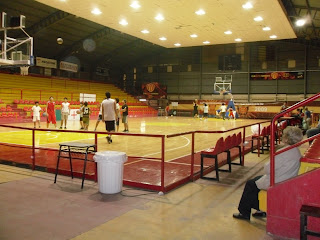The last two days in Resistencia have been pretty excellent. I truly can't say enough about the hospitality extended to me here as a visitor/newcomer of the city and country. Hopefully, my reflections on the events of the last two days will be vivid enough to simply
show how I have experienced such a warm welcome...because I don't think there are ever sufficient words, in quantity or descriptive qualities, to share these feelings related to being welcomed into a new environment. Plus, I'm in need of a little uplift after my Debbie Downer post yesterday...sorry again about that. Cheers -I mean "Here's"- to today! ;)
Thursday, Hannah arrived from Corrientes mid-morning and we headed out for the site of the biannual sculpture festival/competition. Unfortunately, the competition was held last year and won't be held again until July 2012, but, nonetheless, it is an intriguing thing to be living in the nation's capital of sculptures. Smaller sculptures lined the avenue leading to this important place of Resistencia's art culture, but it was a different, almost breath-taking experience to see this site revered among sculptors for the first time. Gracing the vast front lawn of this small museum are numerous large sculptures of competitions past, many reaching a height of a guesstimated 10 feet! Hannah and I perused the front lawn for a bit and then headed inside the fairly large one room museum also showcasing a variety of pieces. When the guide offered to show us a short video promoting the sculpture event, we certainly said yes and, in the process, got a more extended history of the city
and the sculpture competition's origins and ongoing legacy. After eagerly soaking up what I could about these histories, the guide also offered to us: tourist materials for the Chaco province (expected but also very useful as they included a new map with suggestions for restaurants, bars and other cultural centers of the city), a poster advertising next year's competition and a postcard of a sculpture in the city (room decorations!), and a copy of the DVD that we had watched while visiting the museum. What fun culturally relevant texts I have to share with others about where I have lived!
After the museum, it was on to Chabela's, my referente's, house where we shared lunch with her family. With a new face at the table, conversation was lively and entertaining (not out of the ordinary I suppose. haha). We shall fast forward through the post-lunch conversations that we had (see my previous post) and go straight to my discovery of a small grocery store and separate fruit & vegetable market on the same street corner! This is primarily noted as a successful part of the day because these markets will be on my route home from work. Post-neighborhood wandering, I decided that a run was definitely in order so I laced up my shoes and went out on my first run since being here. What an awesome feeling to hit the pavement for the first time in too long! Top the day off with a two hour Skype chat with my sister and I was pretty content.
Friday included numerous other adventures in the city. The day started off with an unsuccessful attempt to meet up with my other referente who works for the ministry of education. Nonetheless, this "failure" allowed me to spend the rest of my morning exploring more of the city and visiting the museum that highlights the history of mass communication in Resistencia. Here, I learned about radio, the newspaper, and film & television in the Chaco province and in larger Argentina. Following lunch with my referente's family, I decided to pursue my introduction to a local middle school English teacher with whom I had been put in contact earlier in the week (huge thanks go out to prior Fulbright ETA in Resistencia, Stephen!). By marvelous chance, this school where Stephen had volunteered during his time here is on the same plaza where I live! An attentive young lady from the main office immediately took me to Claudia Gomez's room where I was warmly welcomed by her and her students and seamlessly integrated into their classroom environment. Their lessons for the day included how to use the verb "to be" (I
am Teresa, I
am from Payne, Ohio, etc.) but with my attendance in the classroom, the lesson's trajectory turned to the students asking me questions using this verb and
many, many other questions that quickly swam to the forefront of their brains . Claudia shared with me later that she was simply amazed at how many of the students were willing to speak up and ask questions of me (relative to their normal participation tendencies). I am enthused at the possibility of volunteering in this classroom and maybe another at this school :) The school day ended a bit early with a collective assembly to honor soldiers of La Guerra de Malvinas [The Malvinas War] (or, better known to much of the rest of the world, as the Falkland Islands) in 1982. This included singing among the students and reading of a few texts, which I'm not sure
anyone could hear/understand at various times because of the sound system's garbled amplification. After school I went with Claudia to meet with some of her friends at
Innova Club, a business of sorts that offers classes, so far, on web design and English for travelers. It was great to meet some of Claudia's friends and just chill, drinking mate for a couple hours. As if I hadn't had enough history for the day, I went next to a cultural center on the central plaza for a memorial exhibit and film on La Guerra de Malvinas. A few veterans of the war welcomed the small crowd that had come and I was personally approached and welcomed by a gentleman who works there at the center. He offered me various texts on the cultural center's main focus (memory in honor of those persecuted, tortured and/or killed during Argentina's military dictatorship) including a full length book produced by the nation's commission on human rights. The commission's hope in giving these books to visitors is that they would be carried to every corner of the earth possible so that such atrocities of abuse in governmental power would not happen again.
I basically crashed after all this and enjoyed a super simple pasta dinner with some grapes that I bought from the guys selling fruits and vegetables across the street from us- Love, love, love these places to buy fresh produce on random streets throughout the city.
My love and many, many hugs to friends and family in the US and abroad that I miss dearly-- you are thought of fondly here in Resistencia.














































